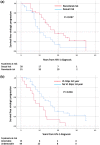High rates of long-term progression in HIV-1-positive elite controllers
- PMID: 33619912
- PMCID: PMC7900439
- DOI: 10.1002/jia2.25675
High rates of long-term progression in HIV-1-positive elite controllers
Abstract
Introduction: Elite controllers (EC) are a rare group of HIV-1-positive individuals who suppress viral loads (VL) to undetectable levels with elevated CD4 T-cell counts in the absence of ART. While rates of short- and mid-term progression have been described in these patients, few studies have focused on their long-term outcome This study aims to describe the virological and immunological behaviour in a cohort of elite controllers followed up for a median of 17 years in the University Hospital, and to identify factors that may be related to disease progression.
Methods: We conducted a descriptive, prospective and single-centre study of all HIV-positive adults recorded in the University Hospital database who met the definition criteria for EC. EC were defined as patients having two consecutive undetectable VL without ART for at least one year. Patients were followed from baseline up to December 2019, to the development of a progression event (loss of VL control, CD4+ T cell decline, AIDS or death) or to the censoring date (lost to follow-up or initiation of ART). Predictive models of progression were calculated.
Results: Fifty-nine EC were identified with a median follow-up of 17 years contributing 1033 PYFU. The median (95% CI) time duration from HIV-1 diagnosis to disease progression was four (1.7 to 6.3) years. Forty-nine (83%) presented progression to the composite end-point, 44 (74.6%) lost viral control, 39 (66.1%) lost immunological control, two developed AIDS and two died. Only 10 patients (16.9%) did not show progression of any kind. Independent predictors of virological progression were sexual risk of HIV-1 acquisition and VL blips during the first year of follow-up (baseline). The only independent predictor detected for progression to a composite end-point was VL blips during the first year of follow-up (baseline).
Conclusions: The rate of long-term progression in EC was very high. Only a minority of patients did not show clinical progression after a median of 17 years of follow-up. These results should be taken in account when considering EC as a model of HIV-1 remission.
Keywords: Elite controllers; HIV-1; outcome; progression.
© 2021 The Authors. Journal of the International AIDS Society published by John Wiley & Sons Ltd on behalf of the International AIDS Society.
Figures
References
-
- Okulicz JF, Lambotte O. Epidemiology and clinical characteristics of elite controllers. Curr Opin HIV AIDS. 2011;6(3):163–8. - PubMed
-
- Leon A, Perez I, Ruiz‐Mateos E, Miguel Benito J, Leal M, Lopez‐Galindez C, et al. Rate and predictors of progression in elite and viremic HIV‐1 controllers. AIDS. 2016;30(8):1209–20. - PubMed
Publication types
MeSH terms
LinkOut - more resources
Full Text Sources
Other Literature Sources
Medical
Research Materials
Miscellaneous



